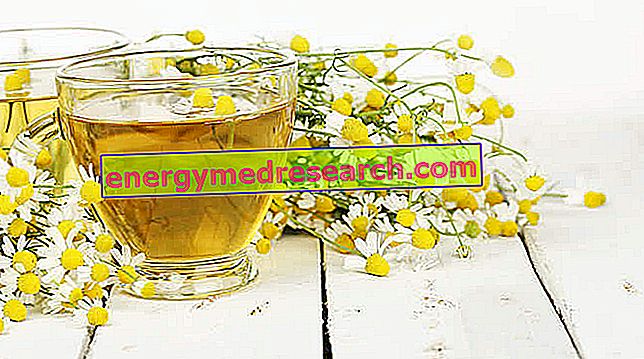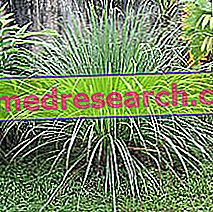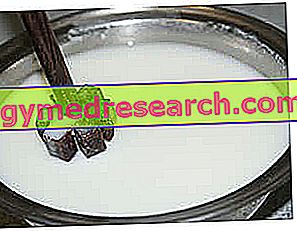Inflammation and anti-inflammatories
Inflammation is a process of defense of the organism, aimed at hindering the agents responsible for a lesion (pathogens, toxins, burns, traumas, etc.), starting in parallel with a reparative process.
Inflammation is recognizable by the onset of 5 phenomena: redness, increased temperature, pain, swelling and reduced function.
The inflammations are not all the same; for example, there are acute and chronic ones. This is a very vast subject that we will not deal with in this article; therefore, for more information on inflammation, consult the dedicated article by clicking here.

Sometimes the inflammation becomes excessive and ends up compromising both the operative capacity of the subject and the integrity of the tissues themselves (which are affected by this phenomenon and can deteriorate). Here is that inflammation can be reduced / hindered by taking products that contain specific active ingredients. These can be classified into: drugs (of synthetic origin) and natural products (leaves, flowers, roots, stolomata, animals or parts of them, algae, etc.).
Drugs include steroidal anti-inflammatory drugs (cortisone or corticosteroids) and non-steroidal anti-inflammatory drugs (NSAIDs, such as salicylates, para-aminophenols, etc.). With regard to natural products, instead, we refer the reading to the next paragraph.
Natural anti-inflammatories
PREMISE
Some products or their active ingredients can enter into metabolic conflict with possible drug therapies. Furthermore, it cannot be ruled out that some of these, in their drug or other parts, may conceal potentially harmful molecules. Before using it, consult your pharmacist and doctor.
The following drugs will be described briefly, neglecting many details of purely scientific interest.
What many people do not know is that most drugs are obtained from natural substrates or their derivatives. Not by chance, both in western herbal medicine and in oriental medicines (Chinese, ayurveda, Japanese or kampo etc.), there are many other remedies that use the same chemical elements. Usually, the shape (food, spices, flowers, roots, leaves, etc.) and the concentration of the drug or drug contained in it change.
Lately, we hear a lot about foods (eg pineapple) that have a hypothetical anti-inflammatory function; however, the first question the reader should ask is: "To what extent and with what dosages would the food have an anti-inflammatory effect?"
Precisely for this reason, instead of listing the products "in vogue", we will first of all cite the most effective ones (with some small hints of pharmacopoeia).
Licorice
Licorice ( Glycyrrhiza glabra, family Fabaceae) is a perennial herbaceous plant that lives in Eastern and Southern Europe, and in Central Western Asia; it is sporadic in the Italian coastal area, where it is cultivated in Abruzzo and Calabria.
The licorice drug is made up of dried roots and stolons (often found not peeled). Licorice has a gray-brown external surface, with evident longitudinal streaks and few rootlets or scars of the branches. The flavor is characteristic, sweetish, then acrid and bitter.
The active ingredients are triterpene saponins ( glycyrrhizin ), flavonoids, starch and simple sugars (glucose, sucrose and mannitol).
The prevalent use of licorice is for anti-inflammatory, gastroprotective and expectorant purposes, thanks to triterpene saponins, which - together with flavonoids - also play an antibacterial and gastric protective role. In association with anthraquinone drugs, the triterpene saponins of licorice also play a laxative role.
The most serious drawbacks of licorice consumption are related to the potential hypertensive effect and to edema due to sodium retention (if taken for long periods).
In pharmacies, licorice is often used as a corrective of taste, bechico, expectorant, against heartburn, gastritis and gastric ulcers. It is suitable for the preparation of thirst-quenching and tonic drinks (eg dark beer).
Licorice is not recommended in combination with digitalis (cardiocinetic) or pregnant drugs.
Arnica
Arnica ( Arnica montana, family Asteraceae) is a perennial herbaceous plant that colonizes the Alpine and Apennine chains; in Italy it is considered a protected species.
The arnica drug consists of its flower heads (rich in terpenes) and its mother tincture.
Its active ingredients are terpenoids ( elenalina ) and flavonoids ( isoquercitrina, astragalina, luteolin-7-glycoside ) and a volatile oil .
The main uses of arnica are mainly external and based on mother tincture, as a local anti-inflammatory and peripheral circulation tonic.
For centuries, it has been used against distortions, bruises, wounds and to mask the chilblains. Arnica is also known for its antirheumatic and antineuralgic effects.
Common or German Chamomile
The German chamomile ( Matricaria chamomilla, family Asteraceae) is an annual herbaceous plant, widespread throughout Europe in places characterized by wasteland.
The German chamomile drug consists of its flower heads with empty receptacle (flowering tops).
The active ingredients are essential oil (consisting of bisabolol, camazulene ), flavonoids ( apigenin, luteolin, quercitrin ) and coumarins .
The main use of German chamomile is as a local anti-inflammatory for the skin and the oral cavity (action ascribed to bisabolol), and as an antispasmodic in gastrointestinal disorders, thanks to the hydrophilic component in apigenin and other flavonoids.
Among the side effects, someone (but rarely) has accused allergy to coumarins.
Roman Chamomile
Roman chamomile ( Chamaemelum nobile, family Asteraceae) is a perennial and pubescent herbaceous plant.
His drug is made up of flower heads with a full receptacle.
The active ingredients of Roman chamomile are polyphenols (derivatives of cinnamic, caffeic, ferulic acid ), coumarins, flavonoids ( apigenin, quercitrin, luteolin ), essential oil ( angelic acid, tiglic, crotonic, etc.), monoterpenes ( cineole and pinene ) and azulenes .
The main uses of this plant are similar to those of German chamomile; therefore spasmolytics for gastrointestinal and anti-inflammatory disorders for the skin and oral cavity. Also known for use in sleep disorders, perhaps supported by the presence of benzodiazepin-like molecules.
Milk thistle
Milk thistle ( Silybum marianum, Asteraceae family) is a biennial herbaceous plant widespread throughout the Mediterranean region.
Its drug consists of the fruits (achenes) deprived of the pappus and obtained by beating the flowering tops; however, even the latter are used in a dried form (although they do not constitute a real drug of pharmacopoeia). NB . The drug must not have a rancid odor or taste.
The active ingredients of milk thistle are contained in its lipid fraction, composed mainly of oleic and linoleic acid, but also characterized by the flavonoid glycosides present in the integuments (silybin, silidianin, silicristina in a 3: 1: 1 ratio, which form the so-called silymarin ) and from polymerized flavonoid derivatives.
The main uses of milk thistle refer mainly to the flavonoid component, and exploit the hepatoprotective action (action at the level of hepatocyte membranes), stimulating hepatocytic, diuretic and pro-digestive proliferation.
Moreover, even the milk thistle plays an important role in the treatment of skin disorders, thanks to the anti-inflammatory action of its related compounds with membrane phospholipids.
All Sources of Omega 3
Omega 3 is a group of essential fatty acids which includes: alpha linolenic acid, docosahexaenoic acid (DHA) and ecosapentaenoic acid (EPA) .
The foods that contain them (such as oily fish, krill, many oil seeds, algae and related oils) contribute to reaching the recommended ration of these molecules, deficient in most of the population.
Omega 3s have different metabolic roles, including: reducing bad cholesterol, triglyceridemia, excess blood pressure, complications related to type 2 diabetes mellitus, cardiovascular risk and the tendency to systemic inflammation.
In particular, omega 3 attenuates the inflammatory reactions that underlie atherosclerosis, asthma and rheumatoid arthritis.
They are also adjuvants in the treatment of psoriasis and other skin diseases; appear to have an anticancer effect, and facilitate the immune and anti-inflammatory response in case of wounds.
The most active chemical forms are DHA and EPA, highly concentrated in marine oils (cod liver oil, fish oil in general, krill oil, algae oil, etc.).
Other Natural Anti-inflammatories
Other less relevant natural inflammatories are:
- Horse Chestnut: fruits of Aesculus hippocastanum, contain triterpene saponins ( escin ), flavonoids ( kaempferol, quercetin and rutin ), coumarins and tannins . The therapeutic properties of the horse chestnut are anti-inflammatory, anti-edema, anti-exudative and venotonic. Possible (but rare) side effects may involve: itching and gastric disorders.
- Rusco: rhizome of Ruscus aculeatus, contains steroidal saponins ( ruscogenin and neoruscogenin ), flavonoids, benzofuranodic derivatives and little essential oil . Its properties are mainly anti-dilating of venous vessels, anti-inflammatory and decontracting. Useful for use in chronic venous insufficiency (IVC).
- Centella: leaves, petioles and stolomi of Centella asiatica, contain triterpene saponins ( asiaticoside, madecassoside, Asian acid, centelloside, etc.), flavonoids ( quercetin, kaempferol, etc.) etc. It has many properties, including anti-inflammatory properties due to the inhibition of prostanoid synthesis (intermediates of the inflammatory process).
- Devil's claw
- Turmeric
Bibliography:
- Pharmacognosy: Botany, chemistry and pharmacology of medicinal plants - Francesco Capasso, R. De Pasquale, G, Grandolini - Springer - pag. 157: 159; 185-186; 213: 219.



